Skateboard Purchasing Guide for Intermediate Skaters
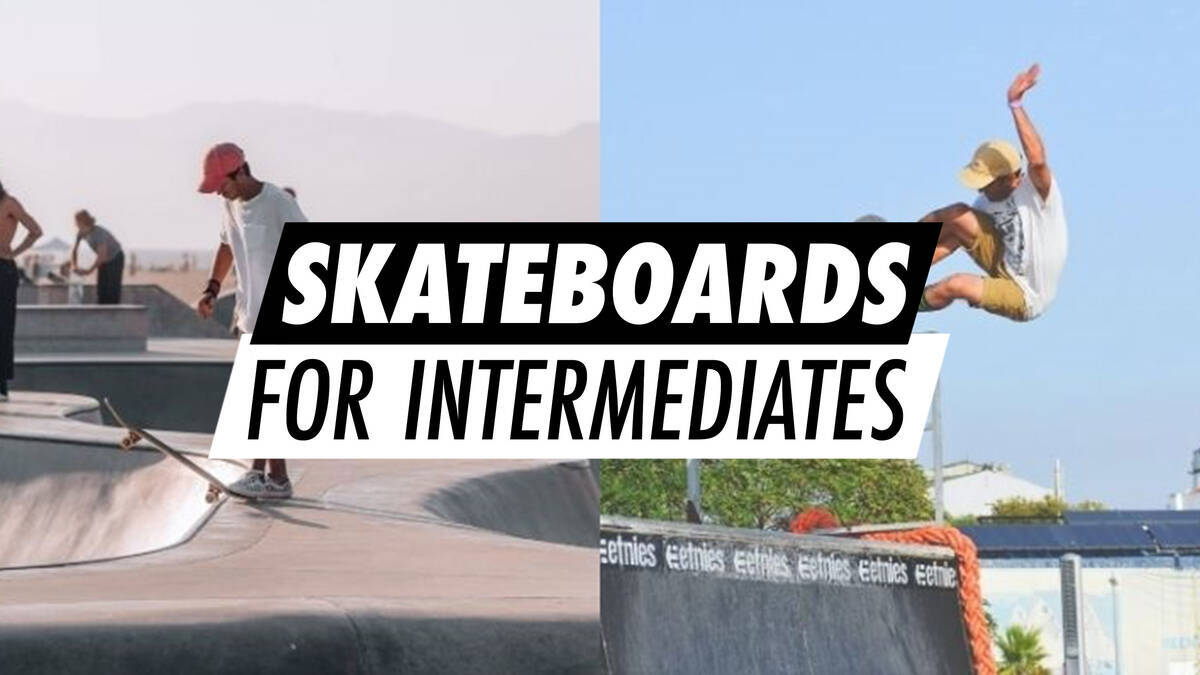
Whether you're acquiring a new complete skateboard or enhancing your current setup with quality parts, this guide is tailored to furnish you with the guidance necessary to purchase the perfect skateboard as an intermediate skateboarder, concentrating on skill development and mastering new tricks.
Overview
Overview
Categories of Skateboards – Varieties for Diverse Styles

Every kind of skateboard comprises a deck, two trucks, and four wheels, but they differ in terms of specifications and measurements. Thus, the initial question you should ponder is: What kind of skateboarder am I?
Is your primary focus on technical flip tricks, or does leaping down large staircases also appeal? Do your preferences lean towards street locations, skateparks, or transition skating, which includes vert and bowls? Your skateboarding style significantly influences your quest to find a skateboard tailored to your needs.
Yet, most skateboarders engage in multiple skateboarding disciplines, and adhering to one discipline alone can be monotonous. Though it's not mandatory to have a distinct skateboard for each discipline, prioritising your main area of interest is beneficial when acquiring a new skateboard.
Below, skateboarding is divided into three primary disciplines: street, park, and transition. But don’t be overly concerned with categories; if you've got a street-focused setup and suddenly feel like skating a bowl – just do it!
Transition Skateboards: Pool and Vert Boards
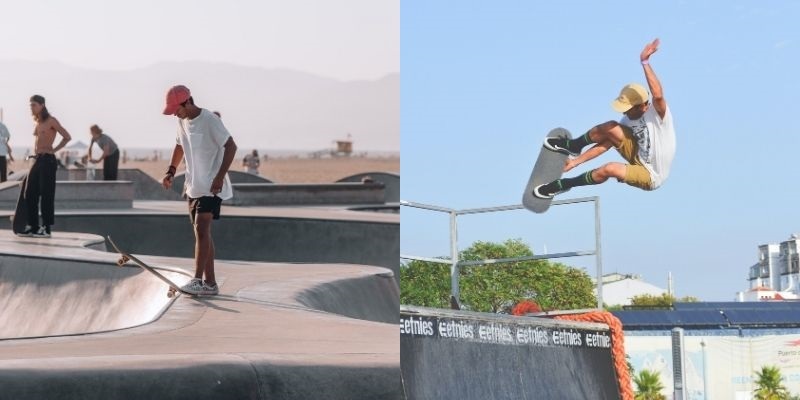
Transition skateboards are crafted for executing tricks on quarter pipes, half pipes, and bowls where transitions shift from horizontal to vertical at a 90-degree angle. Vert skateboarding, a quintessential style, is famed for enormous air tricks on extensive half pipes. Even dropping into a vert demands a fair amount of nerve.
Skating pools and bowls represents a unique facet of transitional skateboarding and actually preceded vert in the skateboarding evolution. Previously, skateboarders would utilise empty swimming pools, and these initial pool skating sessions led to the construction of purpose-built skate pools and bowls.
Transition skateboards, be they pool or vert boards, generally exhibit larger wheels and decks than street configurations. The elevated speeds and larger tricks necessitate a more stable setup. In transition configurations, a larger wheelbase is commonplace, affording added stability and control. However, a larger turning radius arises, which might not be advantageous if you relish "surfing" in pools and bowls, where tighter turns when carving and changing direction might be preferable.
Street Skateboards
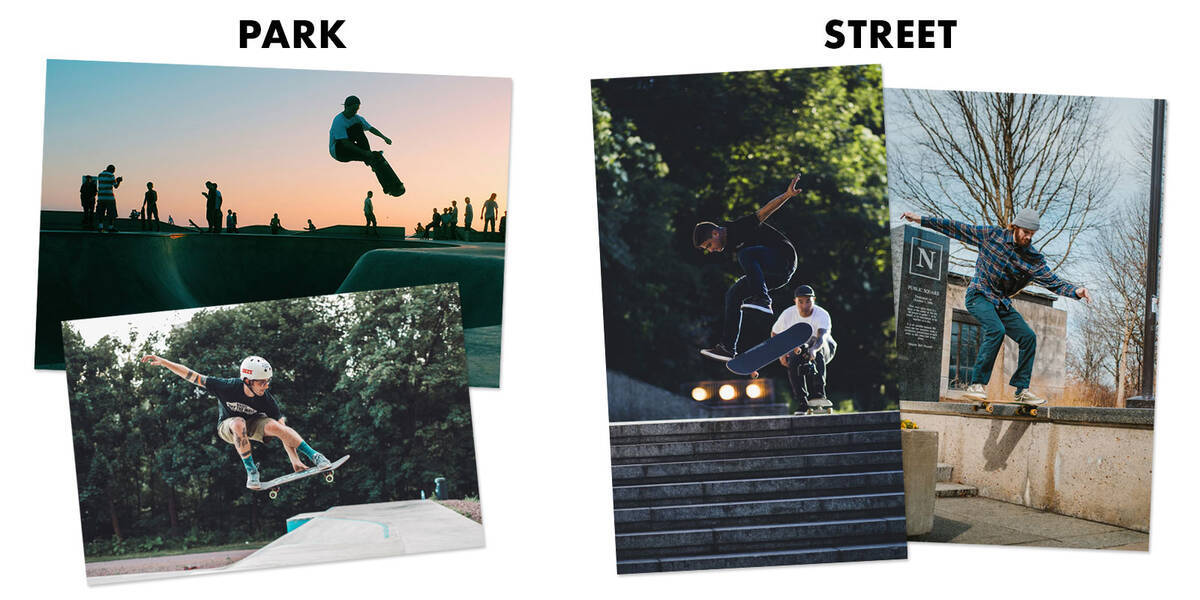
Street skateboards tend to be narrower and lower than those used for transition. They are equipped with smaller, harder wheels for enhanced manoeuvrability and durability, improving responsiveness and facilitating easier flipping and spinning tricks.
Street skateboarding is closely linked with skateboards that have kick tails at both ends. This progression eventually birthed the popsicle-shaped skateboard deck, which is now widely recognised as standard in the skateboarding world. The presence of double kicktails allows for performing sequences involving several tricks in succession, employing the skateboard from every angle, whether in fakie stance or executing popping nollie tricks, etc.
Street skateboarding is also an artistic form that involves reimagining and creatively engaging with urban architecture. Skateboarders redefine urban environments, converting mundane structures like stairs and handrails into sites for personal expression and experimentation. This dynamic synergy between skateboarders and urban landscapes has propelled skateboarding into novel and exciting directions since the late 1980s and early 1990s.
Park Skateboards
The ultimately ideal skateboard setup for park relies on a) your individual tastes and b) the particular park where you most frequently skate. Skateparks are highly diverse, featuring various obstacles from ramps and rails to verts and pools.
Surfaces can range from concrete to asphalt to wooden, and parks vary in size – from substantial arenas crafted for competitions to smaller, improvisational spots for laid-back sessions with friends.
Consequently, there is no universal setup for park skateboarding, and if park skating is your focus, it's logical that your setup is influenced by what performs best at your specific park. For instance, if your favourite park is known for its smooth, slippery floors, selecting a slightly softer durometer could elevate your grip and overall performance.
Complete or Custom Skateboard – Are Complete Skateboards Valuable for Intermediate Skaters?
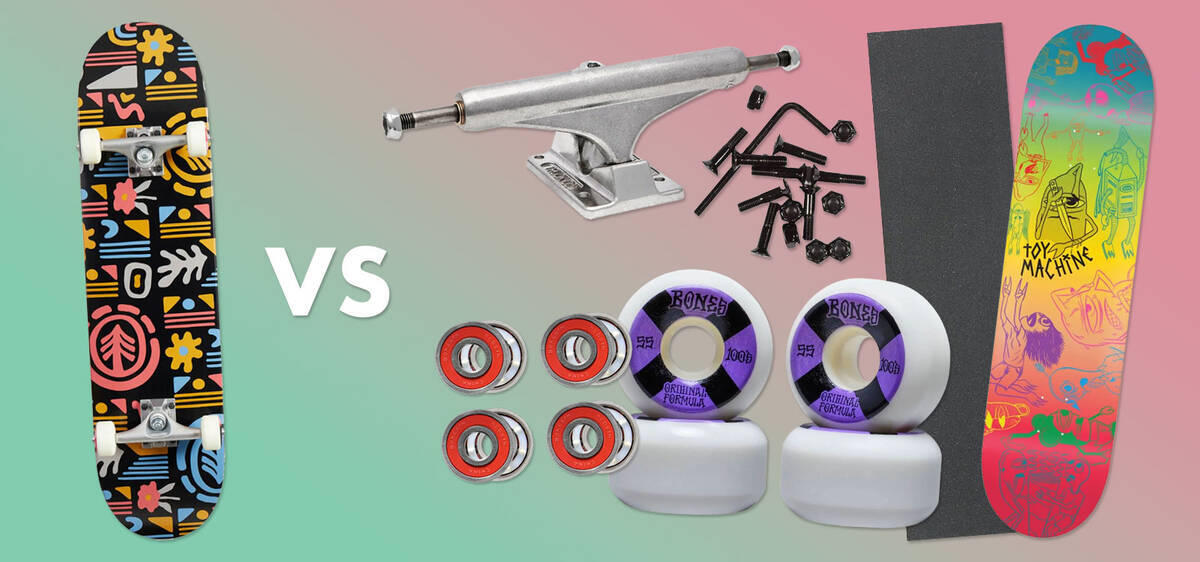
For intermediate skateboarders, opting for a complete skateboard can be a viable choice, especially if their current setup demands an entire overhaul. Nonetheless, ensuring the complete skateboard caters to your specific requirements and is composed of quality parts is paramount.
Although complete skateboards are typically more affordable, they often incorporate parts of lesser quality when compared to assembling them individually. If you choose a complete skateboard, favour reputable skateboard brands and pay keen attention to critical specifications such as deck width, wood type (avoiding Chinese maple), wheel diameter, wheel hardness, and truck manufacturer to secure decent performance and longevity.
Crafting your own skateboard gives you complete control to choose parts according to your preferences. Notably, certain elements of your setup may wear out sooner than others, necessitating customisation.
The lifespan of your skateboard parts is heavily dependent on your skating style. For instance, grinds expedite wear on the trucks, while powerslides wear the wheels. Typically, the deck wears the quickest and thus needs replacement more frequently.
- Browse our range of Complete Skateboards
- Create a custom skateboard with SkatePro's Custom Skateboard Builder
When is the Right Time to Replace Your Skateboard Deck?

Recognising it's time to change your skateboard deck is straightforward when it begins to chip or delaminate, or when it feels softer and loses its initial snappy pop. Even if damage like chipping isn’t visible, decks become saggy over time and less enjoyable to skate. Ultimately, the opportune moment to acquire a new skateboard deck is when you believe it will improve your experience and enhance your enjoyment.
Selecting the Ideal Skateboard Deck
Picking the perfect skateboard deck demands considerations beyond mere appearance. Elements like size, shape, concave, and wood type are vital in determining performance and comfort. Understanding how these factors align with your skating style and your personal preferences is essential when seeking the ideal skateboard deck.
- Size: Choose the right size based on your shoe size and skating style. Ensure the deck width aligns with the axle width of your trucks.
- Wood Types: As an intermediate skateboarder, steer clear from softer wood like Chinese maple, with 7-ply maple being typically ideal.
- Concave: The concave is the deck's curve along its width which significantly impacts the feel and how securely it grips your feet while riding.
For expert advice on skateboard decks, visit here:
How Long do Skateboard Trucks Endure?

Top-quality skateboard trucks can endure for several years, yet there are indicators that replacement is necessary. If hangers wear in a way that disrupts grinds or stalls, or if they’ve been ground entirely to the axle, new trucks are likely required. If the kingpin snaps due to vigorous shredding, replacing only the kingpin is feasible. If your bushings degrade faster than the trucks, acquiring fresh bushings can provide a revitalised feel. Remember that adjusting the tightness of your trucks is always possible by simply tightening or loosening the kingpin nut!
Browse our selection of skateboard trucks and parts to find your needs:
Finding the Perfect Skateboard Trucks
When selecting new skateboard trucks, consider these crucial aspects:
- Size: Ensure truck width matches the deck width to maintain stability and prevent interference with your shoes while executing tricks.
- Truck Height: Decide between low, mid, or high trucks based on your preferences for stability, wheel clearance, and ease of control.
- Truck Weight: Factor in the truck weight as lighter trucks might benefit tricks, but remember weight corresponds to size.
If you seek more information about skateboard trucks, explore our guide:
When is it Time for New Skateboard Wheels?
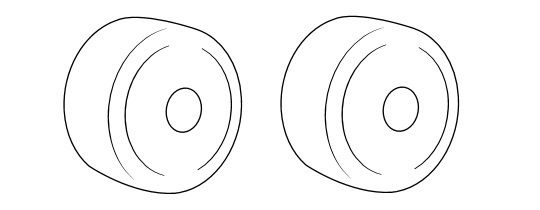
Skateboard wheels are highly durable but will eventually wear with frequent usage. You'll notice they diminish in size or accrue flat spots from uneven wear. Such flat spots can be bothersome and impair your skating experience. If these issues arise, it's time to contemplate new skateboard wheels.
Over time, skateboard wheels wear more quickly on the outer edge, diminishing the riding surface or contact patch. To promote even wear and extend their lifespan, it's advisable to periodically rotate the wheels. Simply remove the wheels and swap them in a cross-pattern: the front right wheel goes to the rear left, and the rear left wheel moves to the front right. Replicate this method for other wheels. This rotation helps in evenly distributing wear across all wheels.
Choosing Ultimate Skateboard Wheels
Here’s a brief overview of considerations when choosing new skateboard wheels:
- Size/Diameter: Pick the correct wheel size relevant to your skateboarding style and terrain preference. Smaller wheels offer nimbleness and responsiveness, while larger ones provide stability and speed.
- Hardness (Durometer): Select suitable wheel hardness based on the surface you skate on and your personal preference for grip versus slide. Softer wheels afford more grip and cushioning, whereas harder ones promise greater speed and robustness.
- Shape and Contact Patch: Evaluate the wheel shape and the size of the contact patch/riding surface. Narrower patches heighten responsiveness and are better for tricks, while wider patches deliver enhanced grip and stability.
Explore further advice on skateboard wheels with our guide:
Skateboard Dimensions: How do You Determine the Appropriate Size?
When picking the correct size for a skateboard deck, it is essential to ensure the width suits your feet and skating preferences, as the deck's width greatly affects its feel during use. Consulting a size chart can help you decide whether a narrower or wider deck fits your shoe size better. A deck that is too narrow might be unstable, while an overly wide one could impede manoeuvrability. Typically, if you sport shoes of European size 45 or above, it is advisable to choose a deck of at least 8 inches in width to ensure successful landings when performing tricks.
Bear in mind that your skateboarding style and personal likes play a critical role when determining the appropriate deck size. Individuals focusing on pool or vert skateboarding might favour a deck wider than what is suggested in the chart.
| Skateboard Width | Recommended Age | Shoe size US | Shoe size UK | Shoe size EU |
| 6.5" | 3 - 5 | 6C - 11C | 5Y - 10Y | 23 - 28 |
| 6.75" | 3 - 5 | 7C - 11C | 6Y - 10Y | 24 - 28 |
| 6.825" | 4 - 6 | 9C - 12C | 8Y - 11Y | 26 - 30 |
| 7.0" | 5 - 7 | 10C - 1 | 9Y - 12Y | 28 - 32 |
| 7.125" | 6 - 8 | 11C - 2 | 10Y - 1 | 29 - 33 |
| 7.25" | 7 - 9 | 12C - 3 | 11Y - 2 | 30 - 34 |
| 7.375" | 8 - 10 | 13C - 4 | 12Y - 3 | 31 - 35 |
| 7.5" | 9 - 11 | 1 - 6 | 13Y - 5 | 32 - 38 |
| 7.625" | 10 - 12 | 2 - 7 | 1 - 6 | 33 - 39 |
| 7.75" | 12 - 14 | 4 - 9 | 3 - 8 | 35 - 42 |
| 7.875" | 12 - 14 | 4 - 9 | 3 - 8 | 35 - 42 |
| 8" & Up | 14 & Up | 9 & Up | 8 & Up | 42 & Up |
Explore our detailed guide:

